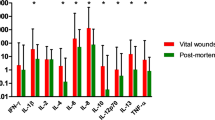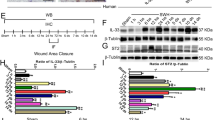Abstract
Immunohistochemical studies on the time-dependent expression of the chemokines such as interleukin (IL)-8, monocyte chemoattractant protein (MCP)-1 and macrophage inflammatory protein (MIP)-1α were performed on 50 human skin wounds with different wound ages (group I 0–12 h, group II 1–4 days, group III 7–14 days and group IV 17–21 days). In the wound specimens with wound ages between 4 and 12 h, neutrophils mainly showed positive reactions for IL-8, MCP-1 and MIP-1α. With increasing wound ages, macrophages and fibroblasts were positively stained with anti-IL-8, MIP-1α and MCP-1 antibodies. Morphometrically, there was a similar distribution in the positive ratios of the inflammatory cells among IL-8, MCP-1 and MIP-1α. The positive ratios of each chemokine were very low in group I and a considerable increase of the positive ratios in each chemokine was observed in group II (mean ± standard error IL-8: 59.8 ± 2.1%, MCP-1: 42.4 ± 3.1% and MIP-1α: 50.4 ± 3.7%). Although the positive ratios for each chemokine gradually decreased according to the wound age, the mean positive ratios in groups III and IV were significantly higher than those in group I. From the forensic aspect, these chemokines are considered useful markers for wound age determination. Thus, ratios of > 50% for IL-8, > 30% for MCP-1 or > 40% for MIP-1α indicate a wound age of at least 1 day. Moreover, the combined investigation of these three chemokines can make wound age determination more objective and accurate.
Similar content being viewed by others
References
Baggiolini M, Dewald B, Moser B (1994) Interleukin-8 and related chemotactic cytokines — CXC and CC chemokines. Adv Immunol 55:97–179
Berger O, Gan X, Gujuluva C, Burns AR, Sulur G, Stins M, Way D, Witte M, Weinand M, Said J, Kim KS, Taub D, Graves MC, Fiala M (1999) CXC and CC chemokine receptors on coronary and brain endothelia. Mol Med 5:795–805
Betz P (1994) Histological and enzyme histochemical parameters for the age estimation of human skin wounds. Int J Legal Med 107:60–68
Betz P, Nerlich A, Wilske J, Tübel J, Wiest I, Penning R, Eisenmenger W (1992) Immunohistochemical localization of fibronectin as a tool for the age determination of human skin wounds. Int J Legal Med 105:21–26
Betz P, Nerlich A, Wilske J, Tübel J, Penning R, Eisenmenger W (1993) Analysis of the immunohistochemical localization of collagen type III and V for the time-estimation of human skin wounds. Int J Legal Med 105:329–332
Betz P, Nerlich A, Wilske J, Tübel J, Penning R, Eisenmenger W (1993) Immunohistochemical localization collagen types I and VI in human skin wounds. Int J Legal Med 106:31–34
Betz P, Nerlich A, Tübel J, Wiest I, Hausmann R (1997) Detection of cell death in human skin wounds of various ages by an in situ end labeling of nuclear DNA fragments. Int J Legal Med 110:240–243
Clark RAF (ed) (1996) Wound repair: overview and general considerations. In: The molecular and cellular biology of wound repair, 2nd edn. Plenum Press, New York London, pp 3–50
Damme JV (1994) Interleukin-8 and related chemotactic cytokines. In: Thomson AW (ed) The cytokine handbook. Academic Press. London, pp 186–208
DiPietro LA (1995) Wound healing: the role of the macrophage and other immune cells. Shock 4:233–240
DiPietro LA, Polverini PJ, Rahbe SM, Kovacs EJ (1995) Modulation of JE/MCP-1 expression in dermal wound repair. Am J Pathol 146:868–875
DiPietro LA, Burdick M, Low QE, Kunkel SL, Strieter RM (1998) MIP-1α as a critical macrophage chemoattractant in murine wound repair. J Clin Invest 101:1693–1698
Dreßler J, Bachmann L, Kasper M, Hauck JG, Müller E (1997) Time dependence of the expression ICAM (CD-54) in human skin wound. Int J Legal Med 110:299–304
Dreßler J, Bachmann L, Koch R, Müller E (1998) Enhanced expression of selectins in human skin wounds. Int J Legal Med 112:39–44
Dreßler J, Bachmann L, Koch R, Müller E (1999) Estimation of wound age and VCAM-1 in human skin. Int J Legal Med 112:159–162
Eisenmenger W, Nerlich A, Glück G (1988) Die Bedeutung des Kollagens bei Wundaltersbestimmung. Z Rechtsmed 100: 79–100
Engelhardt E, Toksoy A, Goebeler M, Debus S, Brocker EB, Gillitzer R (1998) Chemokines IL-8, GROα, MCP-1, IP-10, and Mig are sequentially and differentially expressed during phase-specific infiltration of leukocyte subsets in human wound healing. Am J Pathol 153:1849–1860
Fahey TJ 3rd, Sherry B, Tracey KJ, et al. (1990) Cytokine production in a model of wound healing: the appearance of MIP-1, MIP-2, cachectin/TNF and IL-1. Cytokine 2:92–99
Goede V, Brogelli L, Ziche M, Augustin HG (1999) Induction of inflammatory angiogenesis by monocyte chemoattractant protein-1. Int J Cancer 82:765–770
Grellner W, Vieler S, Madea B (2000) Immunohistochemisches Expressionsmuster von IL-8 und bFGF in menschlichen Hautwunden. Rechtsmedizin 10 [Suppl]:S31
Guan D, Ohshima T, Kondo T (2000) Immunohistochemical study on Fas and Fas ligand in skin wound healing. Histochem J 32:85–91
Jackman SH, Yoak MB, Keerthy S, Beaver BL (2000) Differential expression of chemokines in a mouse model of wound healing. Ann Clin Lab Sci 30:201–207
Kemeny L, Kenderessy AS, Ocsovszky I, Michel G, Ruzicka T, Dobozy A (1995) Interleukin-8 induces the HLA-DR expression on cultured human keratinocytes via specific receptors. Int Arch Allergy Immunol 106:351–356
Kita M (1995) Physiological significance of cytokines. J Clin Exp Med 174:1141–1145
Kitadai Y, Takahashi Y, Haruma K, Naka K, Sumii K, Yokozaki H, Yasui W, Mukaida N, Ohmoto Y, Kajiyama G, Fidler IJ, Tahara E (1999) Transfection of interleukin-8 increases angiogenesis and tumorigenesis of human gastric carcinoma cells in nude mice. Br J Cancer 81:647–653
Kondo T, Ohshima T (1996) The dynamics of inflammatory cytokines in the healing process mouse skin wound: a preliminary study for possible wound age determination. Int J Legal Med 108:231–236
Kondo T, Ohshima T, Eisenmenger W (1999) Immunohistochemical and morphometrical study on the temporal expression of interleukin-1α (IL-1α) in human skin wounds for forensic wound age determination. Int J Legal Med 112:249–252
Kondo T, Ohshima T, Sato Y, Mayama T, Eisenmenger W (2000) Immunohistochemical study on the expression of c-Fos and c-Jun in human skin wounds. Histochem J 32:509–514
Konstantinova NV, Duong DM, Remenyik E, Hazarika P, Chuang A, Duvic M (1996) Interleukin-8 is induced in skin equivalents and is highest in those derived from psoriatic fibroblasts. J Invest Dermatol 107:615–621
Larsen CG, Anderson AO, Appella E, Oppenheim JJ, Matsushima K (1989) The neutrophil-activating protein (NAP-1) is also chemotactic for T lymphocytes. Science 243:1464–1466
Martin P (1997) Wound healing — aiming for perfect skin regeneration. Science 276:75–81
Matsushima K, Oppenheim JJ (1989) Interleukin 8 and MCAF: novel inflammatory cytokines inducible by IL-1 and TNF. Cytokine 1:2–13
Michel G Kemeny L, Peter RU, Beetz A, Reid C, Arenberger P, Ruzicka T (1992) Interleukin-8 receptor-mediated chemotaxis of normal human epidermal cells. FEBS Lett 305:241–243
Oehmichen M (1990) Die Wundheilung. Springer, Berlin Heidelberg New York, pp 5–67
Ohshima T (2000) Forensic wound examination. Forensic Sci Int 113:153–164
Ohshima T, Sato Y (1998) Time-dependent expression of interleukin-10 (IL-10) mRNA during the early phase of skin wound healing as possible indicator of wound vitality. Int J Legal Med 111:251–255
Rebolledo Godoy M., Rebolledo Godoy AP, Oehmichen M (2000) AgNORs during the process of wound healing. Time dependency as evaluated in vital and postmortem biopsy. Int J Legal Med 113:244–246
Sato Y, Ohshima T (2000) The expression of mRNA by proin-flammatory cytokines during skin wound healing in mice: a preliminary study for forensic wound age estimation (II). Int J Legal Med 113:140–145
Sato Y, Ohshima T, Kondo T (1999) Regulatory role of endogenous interleukin-10 in cutaneous inflammatory response of murine wound healing. Biochem Biophys Res Commun 265:194–199
Schröder JM (1995) Cytokine networks in the skin. J Invest Dermatol 105 [1 Suppl]:20S-24S
Singer AJ, Clark RA (1999) Cutaneous wound healing. N Engl J Med 341:738–746
Tuschil A, Lam C, Halsberger A, Lindley I (1992) Interleukin-8 stimulates calcium transients and promotes epidermal cell proliferation. J Invest Dermatol 99:294–298
Author information
Authors and Affiliations
Corresponding author
Rights and permissions
About this article
Cite this article
Kondo, T., Ohshima, T., Mori, R. et al. Immunohistochemical detection of chemokines in human skin wounds and its application to wound age determination. Int J Legal Med 116, 87–91 (2002). https://doi.org/10.1007/s004140100260
Received:
Accepted:
Issue Date:
DOI: https://doi.org/10.1007/s004140100260




